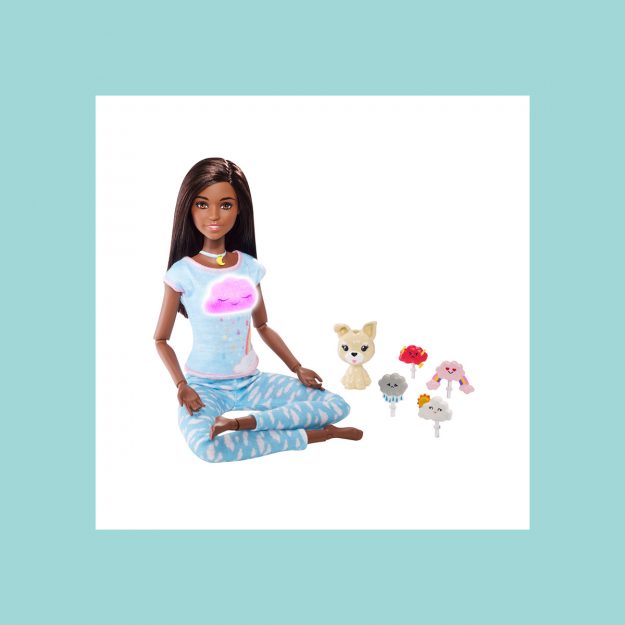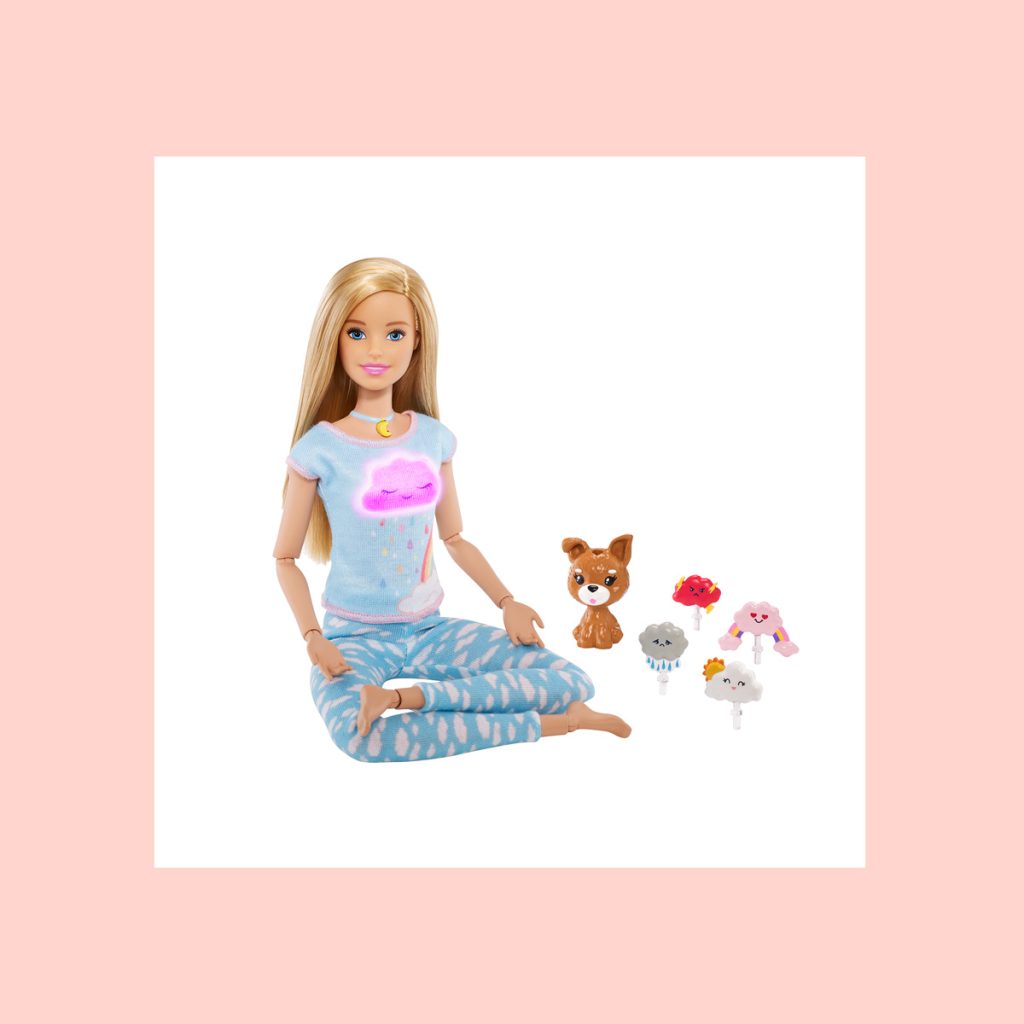Growing up, I played with Barbies.
Barbies who were mermaids, horseback riders, hairdressers, flight attendants, beach fiends. Barbies who brought home gold in the 1998 Winter Olympics. In college I had to confront the dolls’ more controversial reputation. I found out that the Barbies—with their Pollyannaish dispositions, their hard tan plastic mounds for breasts, their legs that squeaked and moved like children’s chopsticks, and their crimped, poofy hair that dwarfed their bodies like Mylar blankets––were crude and problematic symbols that had caused me, without my knowing it, a fair amount of psychic harm. In the following years, new ideas about Barbie flooded out the old ones, and her chirpy, emancipatory claims—“We girls can do anything,” “You can be anything,” “Girls rule”—became specious, and then offensive.
Barbie and I parted ways, but she tip-toed back into my life recently when I saw a tweet from her official account: Barbie has taken up meditation, she announced, to help her cope with an “increasingly busy, over-connected world.” That’s funny, I thought. I mean, she’s always been really busy—balancing multiple careers, playing housewife to a loyal Ken, and paying off the balance for her pink Corvette, dream home, boat, jet, and rocket ship. But now she has decided to take a break from all that, and just sit.
Well, not entirely. Breathe with Me Barbie, as she’s called, is part of Mattel’s new “Wellness Collection,” which features Barbies who partake in cucumber face masks, fizzy baths, and mani-pedis and value fitness and sleep. But Breathe with Me Barbie demands the spotlight here, because while Barbie has been pampered before, this is the first time she has ever meditated.
I immediately wanted to understand what this cross-legged Barbie was all about. Critics were already complaining about how our culture of “wellness” has gone “too far,” and I didn’t want this Barbie to become just another flash point for a sloppy critique of capitalism—perhaps the only aggression she has had to endure more often than having her head twisted off by a younger sibling.
In their 1999 article “Domesticating Barbie,” anthropologists Marlys Pearson and Paul R. Mullins wrote, “Popular and academic commentators alike routinely lapse into apocryphal observations of a few isolated accessories or a single physical attribute of the doll (e.g., hair, breasts), using this indiscriminate inspection as the tenuous foundation from which they can assail, celebrate, or ridicule Barbie symbolism along any number of agendas.” Pearson and Mullins weren’t feeling sorry for Barbie, but they were trying to sort through Barbie’s closet, stuffed with all her past and present looks, to get to a deeper understanding of how and why Barbie came to be––and avoid reducing her to her parts.
Likewise, I wasn’t out to defend Barbie and her newfound interest in self-care and mindfulness, but I did want to know whether or not she was an effective meditation teacher for the children who play with her. So I reached out to mindfulness educator and author Susan Kaiser Greenland, who purchased the doll after I alerted her to Breathe with Me Barbie’s existence.

“Unfortunately, she is both the thesis and the antithesis of a good idea wrapped up in a busty plastic doll,” Susan told me. We video chatted as she moved Barbie around, bending the slender plastic figure into downward dog. Barbie came dressed in “cozy loungewear,” light-blue pajamas printed with little white clouds, and she has “extra flexibility for realistic posing and active play,” meaning she can cross her legs in a sitting meditation posture. (Unfortunately she doesn’t come with a zafu or zabuton.) It was nice to see a liberated Barbie body with flat feet and versatile limbs. “Her chest is appropriately sized, too,” Susan quipped.
“Overall I think the primary message––breathing as a way to get in touch with your emotions and take better care of yourself––is a good one,” she said, adjusting Barbie into an upright half-lotus.
“It’s mainly the interactive, electronic element of the doll that is problematic.” Susan pressed Barbie’s crescent moon shaped necklace.
The purple cloud on Barbie’s chest lit up, tinkling sounds started to play, and Barbie launched into one of her five guided meditations—talking about an imaginary bubble bath and “blowing the biggest bubble” over jingly music. Susan didn’t like this one.
“This is based on an actual guided practice for kids, which has them imagine blowing a bubble, watching it float away, and wishing it well,” she explained. “The objective is to promote calm. But listen to this.” The jingle culminated in a cartoonish popping sound.
Susan pressed the necklace four more times, taking me through all five meditations, which sounded less like the instructions on InsightTimer and more like ringtones from the early 2000s.
It was a little unsettling to hear Barbie be so vulnerable. “Repeat after me: I am strong. I am loved,” Barbie said, as her voice box made scratchy, exaggerated breathing noises. “I’m not a big fan of affirmations,” Susan said. “But if you do like affirmations this one’s not bad.” Hadn’t Barbie always known she was strong and loved?
At the next press of her necklace Barbie shifted into visualization: “Imagine your feelings are fluffy clouds. Now let’s breathe in and out.”
“This one also feels off to me,” said Susan. “What if our emotions feel more like storm clouds? What if our cloud is black with anger or red with shame, or hard as a rock and not fluffy at all? What do we do then?” Barbie didn’t explain; the meditation tune was over in a matter of seconds. I had a hard time imagining Barbie unsmiling.
“No connection is made between the clouds we are imagining and the breathing that comes next,” Susan observed. “The same thing happens with the other track that mentions emotions; it asks how we’re feeling but doesn’t connect our feelings with the sounds or visualizations that she encourages.”
There was also the issue of the light. “Having Barbie’s chest light up in pastel colors like a disco ball is problematic in ways that have nothing to do with meditation.”
“What do you mean?” I asked.
“The purple light is engaging. My guess is that’s the point,” Susan suggested. “I think Mattel is hoping that it will engage kids like a TV show or video game. I get why they want to do that, but the way they’re doing it in this doll is difficult to square [with its purported goals]. This flashy quality is carried into the recordings as well.”
It was slowly becoming clear that Barbie wasn’t very good at this. Despite succeeding at numberless other careers, she was not, judging by my brief encounter with her, an effective meditation teacher.
“Other than hoping to engage the child, there’s no sense that the creator of the meditations had a clear objective for what experience he or she hoped each of the five guided meditations would support,” Susan added, filling in my thoughts. “These don’t create any kind of spaciousness, connection between feelings, or awareness of what’s happening in your mind.”
When I reached out to Mattel about Breathe with Me Barbie, they sent me a fact sheet about the Wellness Collection. “Barbie recognizes the spike in emotional well-being practices among girls and knows that the focus on personal well-being is a movement that is here to stay,” it read. The fact sheet also revealed that the new Barbies are teaming up with meditation app Headspace, where “girls can access a curated playlist of kid-friendly mindfulness and meditation sessions that complement the emotions available through Breathe with Me Barbie.” It included a list of tips for parents, including eight steps to introduce kids to mindfulness, meditation, gratitude practice, and to “encourage feeling emotions.”
I mentioned the Headspace connection to Susan, and she reached out to the app’s co-founder and CEO Rich Pierson, who sent her a statement about the partnership and indicated that Headspace didn’t play a role in making the meditations that go into the doll herself.
“Headspace’s mission is to improve the health and happiness of the world. And to reach the world, we need to meet people where they are, including kids,” he said. “Over 8 million young people are connecting with Barbie on a weekly basis through her YouTube channel. . . Headspace believes it’s important to teach this new generation what mindfulness and meditation is all about.” The Wellness Collection fact sheet said something similar: “As the #1 girls brand on YouTube, with over 9 million subscribers and 13 billion minutes of viewed content, Barbie has a powerful platform to introduce girls to wellness practices in a relatable way.”
In the end, Breathe with Me Barbie turned out to be somewhat of a disappointment. But I am not convinced that she is fundamentally incompatible with meditation. Perhaps she needs some time to settle into the practice—to figure out what works for her.
I still can’t help but wonder if the people eager to make fun of a meditating Barbie are, on some level, harboring some degree of concern about religious authenticity. Maybe they worry that Buddhist meditation has been debased by neoliberalism or capitalism, or in the words of scholar Kathryn Lofton, “something pure has been put to unabashed commodity use.” But, as Lofton aptly observes in her book on the spirituality of another famous American icon, this kind of thinking “says a lot more about what we think is sacred and what we think is profane than about what believers (and consumers) consider sacred and profane.”
While I don’t deny that neoliberal energy is pulsing through the modern-day mindfulness movement, I’m not so sure that this energy necessarily results in unwholesome, or shallow, meditative experiences—or that corporate culture will ultimately convert meditation into just another commodity to be bought and sold. By their own accounts, capitalist forces are also seeking liberation. Neoliberalism does not stealthily obscure its yearnings to produce a certain kind of subject—it proudly announces this goal to whomever it encounters. Margaret Thatcher once said, “Economics are the method; the object is to change the heart and soul.” Neoliberalism tries to free us by creating “free” markets; Barbie tries to do so by showing us that we can have it all. She said it herself: “Girls can do anything.”
Whether or not these methods work (or are good for our spiritual health) is always up for debate. But the question remains: How do we really know that Barbie is bereft of spiritual substance in the first place? How do we know that she isn’t capable of awakening?
Thank you for subscribing to Tricycle! As a nonprofit, we depend on readers like you to keep Buddhist teachings and practices widely available.
